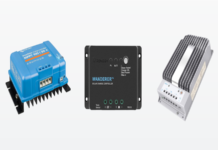You might have come across the question “What is MPPT solar charge controller” and are unable to figure it out.
Or, on the other hand, do you want to know more about solar MPPT charge controllers? Then, you have clicked on the right post.
This powerversity guide is set to provide you with all the necessary information and more that you desire.
I will begin this article with an overview of the MPPT Solar Charge Controller.
Thereafter, I will walk you through how the MPPT solar charge controller works.
In the next section, I will not only list the benefits of an MPPT solar charge controller, but I will also explain them in detail.
What is MPPT Solar Charge Controller: Overview
Your solar panels create more energy when they absorb solar energy than your batteries can store.
Regulating the flow into the battery is necessary for your system to function in order to get the highest flow and storage efficiency.
This is done for your system via a charge controller.
The ideal operating voltages for batteries and solar panels are varied. Additionally, these voltages change throughout time.
A DC-DC converter called an MPPT charge controller increases the effectiveness of a solar power system.
It accomplishes this by maximizing the voltage match between the batteries and the solar panel array.
Voltage and amperage are sent from the solar panels to the system’s battery.
The pressure of the electrons in a system is measured by voltage, and the flow or current of those volts is measured by amperage.
These work together to produce power, measured in watts. The volts and amps flowing through your solar system must be maximized if you want to generate the greatest amount of electricity
A DC-to-DC converter for solar power systems is what the MPPT {Maximum Power Point Tracking} solar charge controller does, as was already mentioned.
It takes the voltage that comes from the solar panels and changes it so that the solar battery is charged at a higher efficiency.
The system’s energy collection and generation are not lost as a result of the optimization, which also increases the amount of energy that can be stored and used.
How Does MPPT Charge Controller Work?
To obtain the most energy out of your solar system, the appropriate ratio of amps and volts is required. Amps are multiplied by volts to get the wattage.
The amperage must be high enough to attain the whole wattage your panel should output if your battery can only support 12 volts.
Calculating this manually might be challenging. The figures are not equal because the panel must provide a higher voltage to maintain equilibrium than the battery.
The maximum power point, which is the point at which your system loses the least solar energy while converting and transporting it through your system, reflects the ideal balance of voltage and amperage to create the greatest power from your solar panel.
Beyond that, the ideal voltage and amperage values for the system change during the day. Here, the angle at which the sun hits your solar panels is important.
Temperatures, precipitation, and cloud cover all have an impact on the levels you require, as well as the best voltage and amperage ratio for your system. One cannot just do a computation to explore all of that.
An MPPT is essential in this situation. The charge controller continuously tracks the ideal levels while digitally monitoring each of these inputs.
The voltage going into the battery and the current coming from the panel are then controlled.
It continuously modifies those levels to bring you as close as possible to the power point’s maximum at any given time so that your system can function at its best.
Benefits of an MPPT Solar Charge Controller
When you make use of an MPPT controller, your solar system’s efficiency and performance will boost dramatically.
It brings several benefits that enable you to save money and accelerate the payback of your solar power system’s original investment.
In reality, MPPT chargers will utilize almost all of the power that is available.
Simply put, it will extract the full amount of power from a module and regulate the voltage and amperage to the optimal battery voltage.
Actually, many MPPT charge controllers are capable of handling voltages that are significantly greater than those of the battery.
You may raise the voltage while maintaining the same current by connecting more modules in series.
Please note that there is a maximum “DC” input voltage for MPPT chargers.
The most modern and costly option is the MPPT charge controller.
Money is wisely spent, in my view.
Hence, you will save some money on the wire, module, and racking investments.
Greater Efficiency in Large Systems
It becomes more crucial as the system expands to maximize the output of each solar panel.
The distinction might be startling for solar systems with many panels.
An MPPT controller should be utilized to increase each panel’s output.
The power available and used will both rise dramatically as a result.
Profit from Investment
Although MPPT solar charge controllers are more expensive, they offer more functionality and lower energy and carbon footprints.
Compared to its opponent, the PWM controller, they assist in realizing these advantages more quickly and thoroughly.
Fewer Panels Are Required
Less solar panel installation is more flexible.
Hence, it saves you money and enables you to concentrate your panels on the areas of your roof that are most positioned to capture and convert the sun’s rays into electricity.
Less Reliant On The Weather
In order to use solar power when the sun isn’t shining, energy must be stored.
The system has a tougher time functioning on days with clouds since the maximum power point fluctuates.
The system’s optimal output is maintained by the MPPT controller, which adapts to changes in the environment.
Increased Power Transfer Efficiency
Due to the battery’s limited capacity, solar charge converters are essential in modifying the electric current flowing from solar panels to the battery.
However, it is possible for the system to store more of the solar panels’ rated wattage since the MPPT controls the voltage and amperage.
For the system to function optimally and to supply all of the required power, efficiency must be increased.
Solar Charge Controllers: MPPT vs. PWM
PWM and MPPT are the two primary categories of solar charge controllers. Due to the better performance, higher charging efficiency, and other benefits detailed below, the latter is the main topic of this article.
PWM Solar Charge Controllers
PWM (pulse width modulation) solar charge controllers employ a simple ‘quick switch’ to modulate or regulate the battery charging and have a direct connection from the solar array to the battery.
Until the battery achieves the absorption charge voltage, the switch (transistor) is open.
The switch then quickly opens and closes (hundreds of times per second) to control the current and keep the battery voltage constant.
The issue is that the solar panel voltage is lowered to match the battery voltage, even though this works fine.
As a result, the panel voltage is pulled below its ideal operating voltage (Vmp), which lowers the panel’s power output and operational effectiveness.
When one or two solar panels are utilized, PWM solar charge controllers are a fantastic low-cost alternative for tiny 12V systems, including straightforward uses like solar illumination, camping, and basic items like USB/phone chargers.
However, if more than one panel is required, they must be connected in parallel rather than in series (unless the battery and panels are substantially different in voltage).
MPPT Solar Charge Controllers
Maximum Power Point Trackers, or MPPTs for short, are much more sophisticated charge controllers. Unlike PWMs that allow solar panels to run at their maximum power points—or, more accurately, at the voltage and current combinations that provide the most amount of power—they run at their lowest possible points.
In accordance with the battery and operational voltage (Vmp) of the solar panel, MPPT solar charge controllers can be up to 30% more efficient.
Detailed explanations of the causes of the improved efficiency and how to build an MPPT charge controller are provided below.
A basic rule of thumb is that MPPT charge controllers should be used on any higher power systems that connect two or more solar panels in line.
5 Best MPPT Solar Charge Controllers And Their Specifications
| Product | Dimension | Weight | Max Input Voltage | Brand |
| MakeSkyBlue 60A MPPT Charge Controller | 8.46 x 1.97 x 4.53 inches | 2.9 Pounds | 160VDC | MakeSkyBlue |
| Renogy 60A 12V/24V/36V/48V DC Input MPPT Solar Charge Controller | 11.22 x 8.07 x 4 inches | 9.35 Pounds | 150VDC | Renogy |
| MPPT Solar Charge Controller 60A 12V 24V 36V 48V Battery System | 7.9 x 3.3 x 11 inches | 8.16 pounds | 150VDC | AMPINVT |
| SUNYIMA 60A MPPT Solar Charge Controller | 7.8 x 4.4 x 1.9 inches | 0.75 Pounds | N/A | SUNYIMA |
| PowMr MPPT Charge Controller | 9.92 x 8.11 x 2.87 inches | 2.86 pounds | 160VDC | PowMr |
What Is MPPT Solar Charge Controllers: Frequently Asked Questions

The solar charger will either stop charging when the battery is full or drastically limit the charge current.
This is particularly true if the system’s DC loads are not using any battery power at the same time.
The MPPT charge control devices outperform PWM devices in terms of efficiency, which is the primary distinction between the two.
According to PWM type, MPPT charge control devices offer a 30% higher charge efficiency. PWM systems call for matching battery and panel voltage.
Though not always steady, it is feasible; it also depends on the loads you are carrying.
The batteries are typically used as a reference for production and voltage stability by inverters and MPPTs
The hybrid inverter enhances solar production by using maximum power point tracking (MPPT) technology.
Additionally, the hybrid inverter regulates the battery charging voltage and guards against overcharging.
Depending on the system architecture, either one can use the MPPT algorithm.
In most cases, buck converters are helpful when the battery system voltage is equal to or lower than 48 V.
The boost converter should be used, however, if the battery system voltage is higher than 48 V.
Every grid-connected solar inverter has a function called Maximum Power Point Tracking (MPPT).
Simply said, this peculiar feature makes sure that your solar panels are constantly operating at their highest efficiency, regardless of the circumstances.
According to calculations, the MPPT lifespan for monocrystalline, polycrystalline, and thin film PV technology is 42.5 years, 46 years, and 47.5 years, respectively.
My Final Though On What Is MPPT Solar Charge Controller
The degree of the variations between the available alternatives for a significant purchase relies on your usage, your demands, and the cost of the item in question.
So, it all boils down to whether your advantages, such as higher energy output, outweigh the longer-term cost rise for an MPPT controller.
The 5 best MPPT solar charge controllers were also highlighted in this post, along with information on what MPPT solar charge controllers are.
Choose wisely from any of the five items listed above, since they were all chosen after taking into account best seller rankings and ratings from past buyers.
Click “Buy Now On Amazon” to submit your order as a result.
I really hope you find this post to be useful.
Fill out the “Leave A Reply” box located towards the bottom of this page to express your opinions.
You might like to read more articles similar to this one. Please look at the following pages:



